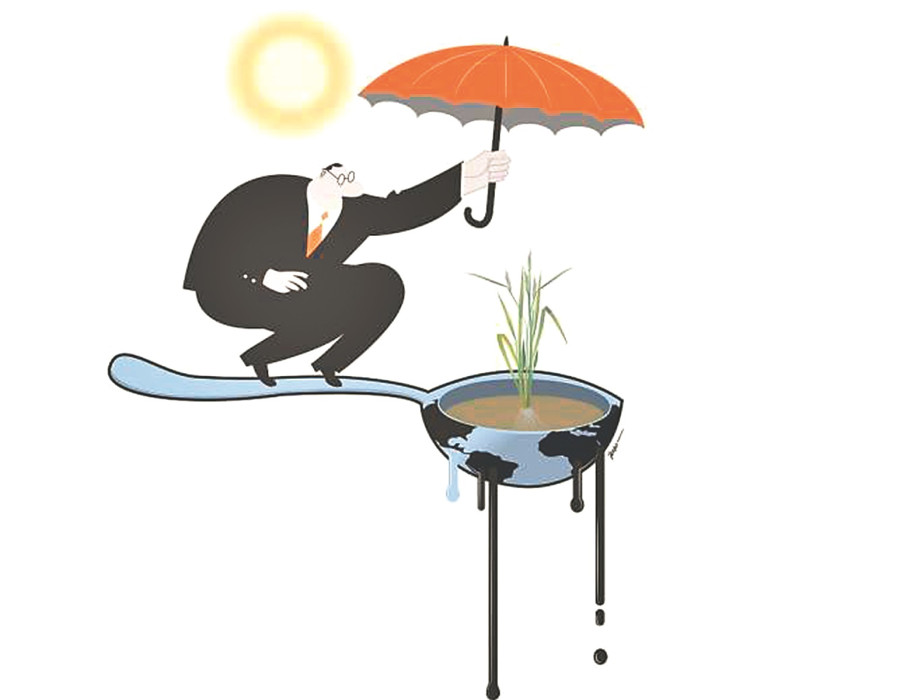Opinion
Feeding the millions
Problem of food insecurity in Nepal can be minimised by adopting various scientific and indigenous techniques
Yubak Dhoj GC
Although the UN focuses on reduction of hunger and malnutrition through specific themes while marking the World Food Day on October 17 annually, some 795 million people in the world do not have enough food to lead a healthy and active life. A major proportion of this population lives in underdeveloped regions like South Asia, which is also threatened by climatic changes. Thus, Nepal marked this year’s World Food Day with the theme “Climate is changing. Food and agriculture must too.” The major thrust of the annual event is to raise awareness among the producers, technicians and various other stakeholders about increased food production by counteracting the impacts of climate-related hazards.
Over the years, the government has put ample emphasis on production boosting programmes by linking science to practice, like adoption of improved technology, focused programmes based on agricultural zonations, mechanisation, scientific production, marketing and diversification of products through value chain, subsidy and grants in seeds, fertilizers, irrigation, insurance, machines, etc. Emphasis has also been given to commercialisation through diversification and modernisation.
Despite this, about 30 districts, mostly situated in the mid-western region, remain food insecure. The International Food Policy Research Institute (IFPRI) reports that the problem of food insecurity in the country is serious. The underlying causes of food insecurity in Nepal are complex—it is not merely due to low production but largely due to the demand for rice-based food items and the challenges of distribution. Other reasons are the low purchasing power of the people and the unavailability of nutritious food at the desired places and time. Food security in recent years is thus viewed as more than just a production issue.
Effects of climate change
In Nepal, agriculture is still the largest contributor to the GDP. But as most of the working-age population is in foreign lands for employment, there is inadequate manpower in the country for the sector. Even those who are currently involved in agriculture lack knowledge about scientific farming. Furthermore, water shortages and erratic weather patterns lower farm productivity.
The unprecedented rise in temperature and erratic rainfall, humidity, drought and wind patterns have direct and indirect impacts on agriculture. Farmers across the country are already facing some unusual instances such as poor grain or no formation of grain in rice and maize. The cropping cycle is shortening. Similarly, many biotic and abiotic stresses are noticed in several vegetables, fruits, animals, aquaculture and so on. Various crop pests and diseases have caused havoc and massive crop losses have been reported. Because of the delayed monsoon, some crop varieties and species have shifted their production cycle.
Despite the adverse effects of climate change, we can still take some advantage from it. A study shows that Nepal’s average temperature was 14.80C in 1850 but it reached 15.80C in 2000. So there has been a shift of temperature from one agro-climatic region to another. The temperature found until a few years ago in the Tarai is now found in the mid-hills and the temperature in the mid-hills is now found in high hills. The agro-ecological zones of crops, vegetables, fruits, and flora and fauna might have changed. And the change might have an effect on crop biology such as their growth, flowering, ripening, etc. This suggests that the cropping intensity could have increased in the cooler climatic high-hill regions like Mustang and the districts in Karnali. It may help boost the production of crops in these areas. This assumption, however, needs to be backed by research.
Important message
At present, agriculture has to deal with many issues besides climate change. Cultivation areas have been shrinking due to the transformation of farmlands into real estate. Agricultural inputs have become more expensive, resulting in high cost of production. Middlemen are profiting more than the producers because of scattered and scanty production.
But with regard to climate change, adaptation or minimising loss and damage through innovative ideas is the only option for Nepal. For instance, the need for water can be managed by harvesting rainwater, conserving and managing moisture and shifting the date of plantation. Likewise, rice varieties requiring smaller amounts of water can be transplanted in drought-prone areas. Also, there are flood-resistant, sub-mergence tolerant, insects- pests- and disease resistant varieties developed by various institutions. Several botanical and homemade materials can be used instead of chemical pesticides. Bio-pesticides is another option that has the potential to minimise the need for chemical pesticides in Nepal.
Agriculture can be made more eco-friendly by taking into consideration the traditional practices of Nepali farmers. Crop seeds can be preserved locally and biotic problems can be minimised using indigenous techniques, which do not require sophisticated and costly technologies. Use of solar power has already proved to be a viable option across Tarai—with the investment of about Rs1,200,000 for a solar irrigation system, more than two hectares of land can be irrigated. Some Climate Smart Village programmes have demonstrated the possibility of using such technology across the length of the Tarai from Jhapa to Kanchanpur. Zero-energy water lifting can also be used in the mid-hills. Such knowledge and techniques work hand in hand to respond to climate change challenges. These are important messages that we can learn and communicate to our end-users, technicians and other stakeholders.
GC is Director General of Department of Agriculture and former Director General of Department of Environment




 18.12°C Kathmandu
18.12°C Kathmandu










